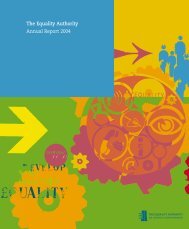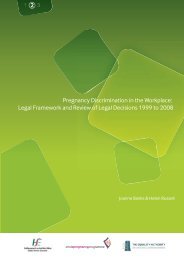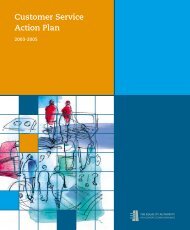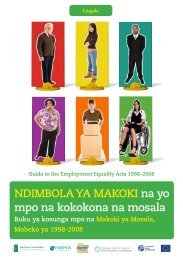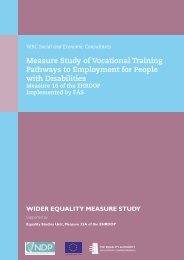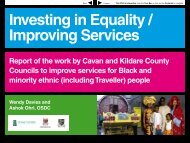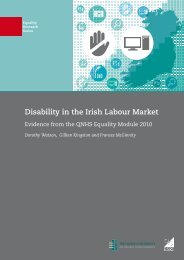Annual Report 2000.pdf (size 2.3 MB) - Equality Authority
Annual Report 2000.pdf (size 2.3 MB) - Equality Authority
Annual Report 2000.pdf (size 2.3 MB) - Equality Authority
You also want an ePaper? Increase the reach of your titles
YUMPU automatically turns print PDFs into web optimized ePapers that Google loves.
Analysis - Enforcement underpinning<br />
social change<br />
The figures clearly demonstrate that there is a great need for basic<br />
information on the operation of the five Acts. In 2000, the amendments<br />
to the Parental Leave Act, 1998 were of particular interest.The<br />
implementation of the Equal Status Act, 2000 in October attracted an<br />
unprecedented amount of enquiries.<br />
Key Objective 1<br />
One of the challenges facing the <strong>Equality</strong> <strong>Authority</strong> is the development of<br />
all nine grounds on an equal footing with no diminution of gains already<br />
achieved in the gender area. It is too early to identify with certainty any<br />
trends. In 2000 cases were taken on eight of the nine grounds. Gender<br />
cases constituted over half of the cases, which is no surprise given that<br />
there is over 20 years experience of gender discrimination. It is, however,<br />
surprising and regrettable that sexual harassment and pregnancy-related<br />
discrimination are still so prevalent. Harassment is also emerging as an<br />
issue across all grounds. Under the new grounds, the cases tend to<br />
concern more blatant acts of discrimination. In cases taken on the age<br />
ground, access to promotion is the most regular area of complaint.<br />
Access to employment is a major issue with cases taken on the disability,<br />
race and Traveller community grounds.Two claims that were settled on<br />
the disability ground involved the provision of reasonable<br />
accommodation. Dismissal is a major issue in cases on the sexual<br />
orientation ground. The <strong>Equality</strong> <strong>Authority</strong> has sought to establish why<br />
there is a low level of cases under the race ground and the sexual<br />
orientation ground in particular. A reluctance to identify and draw<br />
attention to oneself has been suggested as an explanation for low take-up<br />
in these areas.The exemption for religious educational or medical<br />
institutions in Section 37 of the 1998 Act is also presented as a major<br />
obstacle to claims of discrimination on grounds of sexual orientation.<br />
Undoubtedly, the biggest achievement in the area of enforcement was the<br />
landmark recommendation of the Labour Court in Dr. Noreen Gleeson -<br />
v- the Rotunda Hospital and the Mater Hospital. The award of £50,000<br />
was the highest award made to date in the area of gender discrimination<br />
and was significantly higher than earlier awards and marked a sea-change<br />
in the potential for discrimination awards. This was reflected in the<br />
settlement of £40,000 which was achieved subsequently in a pregnancy<br />
discrimination case.The rights which are afforded by the legislation can<br />
only be enforced in a meaningful way by the award of significant<br />
compensation.The challenge is to ensure that compensation awards are<br />
Key Objective 1 - <strong>Annual</strong> <strong>Report</strong> 2000 - The <strong>Equality</strong> <strong>Authority</strong> page 43




